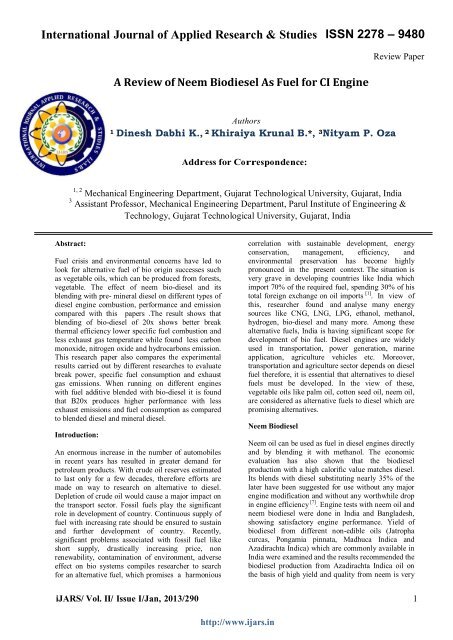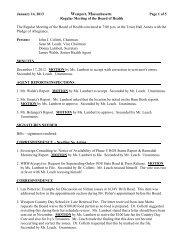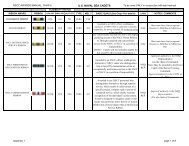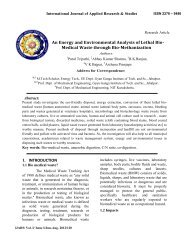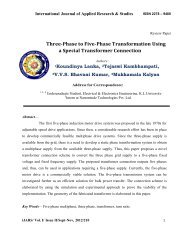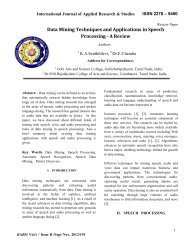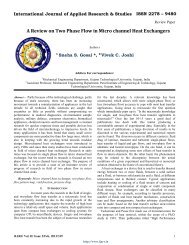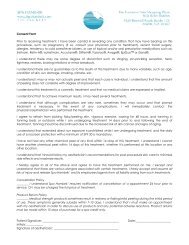A Review of Neem Biodiesel As Fuel for CI Engine - Hgsitebuilder ...
A Review of Neem Biodiesel As Fuel for CI Engine - Hgsitebuilder ...
A Review of Neem Biodiesel As Fuel for CI Engine - Hgsitebuilder ...
Create successful ePaper yourself
Turn your PDF publications into a flip-book with our unique Google optimized e-Paper software.
International Journal <strong>of</strong> Applied Research & Studies ISSN 2278 – 9480<br />
A <strong>Review</strong> <strong>of</strong> <strong>Neem</strong> <strong>Biodiesel</strong> <strong>As</strong> <strong>Fuel</strong> <strong>for</strong> <strong>CI</strong> <strong>Engine</strong><br />
<strong>Review</strong> Paper<br />
Authors<br />
1 Dinesh Dabhi K., 2 Khiraiya Krunal B.*, 3 Nityam P. Oza<br />
Address <strong>for</strong> Correspondence:<br />
1, 2 Mechanical <strong>Engine</strong>ering Department, Gujarat Technological University, Gujarat, India<br />
3 <strong>As</strong>sistant Pr<strong>of</strong>essor, Mechanical <strong>Engine</strong>ering Department, Parul Institute <strong>of</strong> <strong>Engine</strong>ering &<br />
Technology, Gujarat Technological University, Gujarat, India<br />
Abstract:<br />
<strong>Fuel</strong> crisis and environmental concerns have led to<br />
look <strong>for</strong> alternative fuel <strong>of</strong> bio origin successes such<br />
as vegetable oils, which can be produced from <strong>for</strong>ests,<br />
vegetable. The effect <strong>of</strong> neem bio-diesel and its<br />
blending with pre- mineral diesel on different types <strong>of</strong><br />
diesel engine combustion, per<strong>for</strong>mance and emission<br />
compared with this papers .The result shows that<br />
blending <strong>of</strong> bio-diesel <strong>of</strong> 20x shows better break<br />
thermal efficiency lower specific fuel combustion and<br />
less exhaust gas temperature while found less carbon<br />
monoxide, nitrogen oxide and hydrocarbons emission.<br />
This research paper also compares the experimental<br />
results carried out by different researches to evaluate<br />
break power, specific fuel consumption and exhaust<br />
gas emissions. When running on different engines<br />
with fuel additive blended with bio-diesel it is found<br />
that B20x produces higher per<strong>for</strong>mance with less<br />
exhaust emissions and fuel consumption as compared<br />
to blended diesel and mineral diesel.<br />
Introduction:<br />
An enormous increase in the number <strong>of</strong> automobiles<br />
in recent years has resulted in greater demand <strong>for</strong><br />
petroleum products. With crude oil reserves estimated<br />
to last only <strong>for</strong> a few decades, there<strong>for</strong>e ef<strong>for</strong>ts are<br />
made on way to research on alternative to diesel.<br />
Depletion <strong>of</strong> crude oil would cause a major impact on<br />
the transport sector. Fossil fuels play the significant<br />
role in development <strong>of</strong> country. Continuous supply <strong>of</strong><br />
fuel with increasing rate should be ensured to sustain<br />
and further development <strong>of</strong> country. Recently,<br />
significant problems associated with fossil fuel like<br />
short supply, drastically increasing price, non<br />
renewability, contamination <strong>of</strong> environment, adverse<br />
effect on bio systems compiles researcher to search<br />
<strong>for</strong> an alternative fuel, which promises a harmonious<br />
correlation with sustainable development, energy<br />
conservation, management, efficiency, and<br />
environmental preservation has become highly<br />
pronounced in the present context. The situation is<br />
very grave in developing countries like India which<br />
import 70% <strong>of</strong> the required fuel, spending 30% <strong>of</strong> his<br />
total <strong>for</strong>eign exchange on oil imports [1] . In view <strong>of</strong><br />
this, researcher found and analyse many energy<br />
sources like CNG, LNG, LPG, ethanol, methanol,<br />
hydrogen, bio-diesel and many more. Among these<br />
alternative fuels, India is having significant scope <strong>for</strong><br />
development <strong>of</strong> bio fuel. Diesel engines are widely<br />
used in transportation, power generation, marine<br />
application, agriculture vehicles etc. Moreover,<br />
transportation and agriculture sector depends on diesel<br />
fuel there<strong>for</strong>e, it is essential that alternatives to diesel<br />
fuels must be developed. In the view <strong>of</strong> these,<br />
vegetable oils like palm oil, cotton seed oil, neem oil,<br />
are considered as alternative fuels to diesel which are<br />
promising alternatives.<br />
<strong>Neem</strong> <strong>Biodiesel</strong><br />
<strong>Neem</strong> oil can be used as fuel in diesel engines directly<br />
and by blending it with methanol. The economic<br />
evaluation has also shown that the biodiesel<br />
production with a high calorific value matches diesel.<br />
Its blends with diesel substituting nearly 35% <strong>of</strong> the<br />
later have been suggested <strong>for</strong> use without any major<br />
engine modification and without any worthwhile drop<br />
in engine efficiency [7] . <strong>Engine</strong> tests with neem oil and<br />
neem biodiesel were done in India and Bangladesh,<br />
showing satisfactory engine per<strong>for</strong>mance. Yield <strong>of</strong><br />
biodiesel from different non-edible oils (Jatropha<br />
curcas, Pongamia pinnata, Madhuca Indica and<br />
Azadirachta Indica) which are commonly available in<br />
India were examined and the results recommended the<br />
biodiesel production from Azadirachta Indica oil on<br />
the basis <strong>of</strong> high yield and quality from neem is very<br />
iJARS/ Vol. II/ Issue I/Jan, 2013/290 1<br />
http://www.ijars.in
International Journal <strong>of</strong> Applied Research & Studies ISSN 2278 – 9480<br />
pr<strong>of</strong>itable. Physical and chemical properties <strong>of</strong> neem<br />
oil, neem methylester and conventional diesel are<br />
presented<br />
in Table 1 .The fuel properties <strong>of</strong> neem biodiesel<br />
were within the limits and comparable with the<br />
conventional diesel. Except calorific value, all other<br />
fuel properties <strong>of</strong> neem biodiesel were found to be<br />
higher as compared to diesel.<br />
TABLE 1: PROPERTIES OF NEEM OILS AND ITS ESTER [7]<br />
Properties Diesel <strong>Neem</strong> oil <strong>Neem</strong><br />
biodiesel<br />
Density(kgm -3 ) 830 912–965 820–940<br />
Viscosity(cSt) 4.7 20.5–48.5 3.2–10.7<br />
Flashpoint( C) 60 214 120<br />
Cetane number 45 31–51 48–53<br />
Calorific value(MJkg-1) 42 32–40 39.6–40.2<br />
Sulphur (ppm) 0.042 1990 473.8<br />
Iodine value ---- 65-80 ----<br />
Titre( C) ---- 35-36 ----<br />
Fire point( C) 65 222 128<br />
Pour point( C) -16 10 2<br />
Cloud point( C) -12 19 9<br />
Total glycerine (%) ---- ---- 0.26<br />
Free glycerine (%) ---- ---- 0.02<br />
Oxidation stability 3-6 min 12.4 7.1<br />
(h),110 C<br />
Coldfilter plugging ---- 11 ----<br />
point( C)<br />
Carbon residue(%mass) 0.17 ---- 0.105<br />
Water content (%) 0.02 0.098 0.036<br />
Non Edible oil composition and its Potential in<br />
India<br />
Anindita Karmakar et al. [7] assessed and integrated<br />
the biological, chemical and genetic attributes <strong>of</strong> the<br />
plant and describes about the different tree borne<br />
oilseeds in India. Non edibles oils from the sources<br />
such as neem mahua, pongamia ,karanji, babassu,<br />
and jatropha, are easily available in many parts <strong>of</strong> the<br />
world including India, and are very cheap compared<br />
to edible oils.. In India, there are several non -edible<br />
oils from different species such as Pungam<br />
(Pongamia pinnata), Jatr<strong>of</strong>a (Jatr<strong>of</strong>a curcas), <strong>Neem</strong><br />
(Azadirachta indica) Mahua (Madhuca indica) and<br />
Simarouba (Simarouba indica) , which could be<br />
utilized <strong>for</strong> biodiesel production processes.<br />
According to a survey conducted in 2002, 12 species<br />
have been selected <strong>for</strong> its importance <strong>of</strong> present<br />
industrial usage and abundance in distribution [7] .<br />
Transesterification and Esterification Process<br />
Pravin A. Manade et [10] .al utilized bi<strong>of</strong>uel from two<br />
different production process: esterification called<br />
ethyl esters and transesterification called methyl<br />
ester. They found that fuel is rather viscous<br />
compared to diesel. Chemically is equivalent to<br />
fatty acid methyl esters or ethyl esters, produced<br />
out <strong>of</strong> triacylglycerol (triglycerides) via<br />
transesterification or out <strong>of</strong> fatty acids via<br />
esterification. Transesterification (alcoholysis) is a<br />
reversible reaction in which one ester is converted<br />
into another by interchange <strong>of</strong> ester groups. In the<br />
reaction one mole <strong>of</strong> triglyceride oils contained in<br />
vegetable oils, animal fats, or recycled greases,<br />
reacts with three moles <strong>of</strong> alcohol to <strong>for</strong>m one<br />
mole <strong>of</strong> glycerol (glycerine) and three moles <strong>of</strong> the<br />
fatty acid alkyl ester (biodiesel). In order to shift<br />
the equilibrium to the right, an alcohol, typically<br />
methanol is added in an excess over the<br />
stoichiometric amount, but ethanol can also be use.<br />
The two main products, glycerol and fatty acid<br />
methyl/ ethyl esters (FAME/FAEE), are hardly<br />
miscible and thus <strong>for</strong>m separated phases: un upper<br />
ester phase and a lower glycerol phase. After<br />
transesterification the properties <strong>of</strong> crude vegetable<br />
oil like density, viscosity, cetane number, calorific<br />
value, vaporization rate, and molecular weight are<br />
improved<br />
[10] . The representation <strong>of</strong><br />
transesterification chemical reaction is shown in<br />
equation 2.1.Triglycerides called as vegetable oil and<br />
R 1 , R 2 and R 3 represents the fatty acid.<br />
CH 2 -00C-R l R I -COO-R CH 2 -0H<br />
CH - OOC-R 2 +3CH 3 0H<br />
R 2 -COO-R + CH - OH<br />
CH 2 -00C-R 3 R 3 -COO-R CH 2 -0H<br />
(1)<br />
Author attributed that esterification is the process<br />
by which a fatty acid reacts with a mono-alcohol<br />
to <strong>for</strong>m an ester. This reaction is a typically<br />
equilibrium reaction, so to increase the yield <strong>of</strong> fatty<br />
acid alkyl esters it is necessary to use an excess <strong>of</strong><br />
alcohol or to remove one <strong>of</strong> the end products out <strong>of</strong><br />
the equilibrium. The representation <strong>of</strong> esterification<br />
chemical reaction is shown in equation .2.<br />
R 1 COOH + CH 3 0H H + R 1 COOCH 3 + H 2 0<br />
R 1 COOH + C 2 H 5 0H H + R 1 COOC 2 H 5 + H 2 0<br />
(2)<br />
Anindita Karmakar et.al [7] evaluated that the most<br />
commonly used method to produce biodiesel from<br />
iJARS/ Vol. II/ Issue I/Jan, 2013/290 2<br />
http://www.ijars.in
International Journal <strong>of</strong> Applied Research & Studies ISSN 2278 – 9480<br />
crude vegetable oils and animal fats are to<br />
transesterify vegetable oils and animal fats to an<br />
alkyl ester to reduce their viscosity and increase in<br />
their volatility. The reaction <strong>of</strong> fats or oils with alcohols<br />
to produce biodiesel is called transesterification.<br />
In general, there are two methods <strong>of</strong><br />
transesterification. One method employs a catalyst<br />
and another one is non-catalyst options such as<br />
super- critical processes, and co-solvent systems. A<br />
catalyst is employed to increase the reaction rate and<br />
yield. They analyzed that Various catalysts used are<br />
base catalysts that include NaOH, KOH, and<br />
NaMeO, acid catalysts that include H 2 SO 4 ,H 3 PO 4 ,<br />
and CaCO 3 and lipase enzymes. Methanol and<br />
ethanol are the two main light alcohols used <strong>for</strong><br />
transesterification process. For biodiesel production<br />
alkaline or acidic catalysts are frequently used. The<br />
alkali-catalyzed reaction is reported to be much<br />
faster than acid-catalyzed one. Enzymes are also used<br />
as catalyst <strong>for</strong> trans- esterification. Glycerol is an<br />
important byproduct which can be burnt <strong>for</strong> heat or<br />
used as feedstock in cosmetic industry. Base<br />
catalyzed biodiesel production process generally<br />
consists <strong>of</strong> unit operations <strong>of</strong> transesterification<br />
reaction, distillation <strong>for</strong> recovery <strong>of</strong> excess alcohol,<br />
water washing <strong>for</strong> separating biodiesel from<br />
glycerol, catalyst and alcohol, distillation <strong>for</strong> crude<br />
biodiesel purification and glycerol purification. Fig.<br />
shows the process flow chart <strong>of</strong> generalized biodiesel<br />
production methods.<br />
FIG.1: PROCESS SELECTION AND STEPS FOR BIODIESEL<br />
PRODUCTION[7]<br />
Per<strong>for</strong>mance <strong>of</strong> neem bio-diesel blends with Diesel in<br />
<strong>CI</strong> <strong>Engine</strong><br />
Atul Dhar et. al [11] investigated per<strong>for</strong>mance <strong>of</strong> <strong>CI</strong><br />
engine using non edible oil and blend <strong>of</strong> oil with diesel<br />
produced from neem.A wide range <strong>of</strong> engine loads and<br />
volumetric blends <strong>of</strong> 5% neem biodiesel and 95%<br />
diesel, 10% neem biodiesel and 90% diesel, 20% neem<br />
biodiesel and 80% diesel, 50% neem biodiesel and 50%<br />
diesel are used <strong>for</strong> per<strong>for</strong>mance measurement <strong>of</strong><br />
vertical, 4 stroke, single cylinder, constant speed, direct<br />
injection, water cooled, compression ignition engine <strong>of</strong><br />
Kirloskar oil engine model no. DM-10. R.Senthilkumar<br />
et al [12] investigated the per<strong>for</strong>mance and combustion<br />
characteristics <strong>of</strong> Kirloskar made, single cylinder,<br />
naturally aspirated, water cooled, direct injection diesel<br />
engine running on diesel, volumetric blends <strong>of</strong> 10%<br />
neem biodiesel and 90% diesel, 30% neem biodiesel<br />
and 70% diesel, 40% neem biodiesel and 60% diesel,<br />
50% neem biodiesel and 50% diesel. Nishant Tyagi et.<br />
al [13] evaluated the per<strong>for</strong>mance and emission<br />
characteristics <strong>of</strong> C I engine using diesel, 10% neem<br />
biodiesel and 90% diesel, 20% neem biodiesel and 80%<br />
diesel, 30% neem biodiesel and 70% diesel.The<br />
following per<strong>for</strong>mance and emission parameters<br />
investigated.<br />
Brake thermal efficiency<br />
Atul Dhar et. al [11] reported that brake thermal efficiency<br />
was highest among all test fuels. All blends showed<br />
higher brake thermal efficiency than mineral diesel.<br />
Author found 20% efficiency with mineral diesel, 23%<br />
efficiency with pure biodiesel <strong>of</strong> 100% blend, which is<br />
15% higher. They attributed this increase in brake<br />
thermal efficiency is due to presence <strong>of</strong> oxygen in the<br />
biodiesel molecules which improves the combustion<br />
efficiency. R.Senthilkumar et al [12] observed that the<br />
brake thermal efficiency <strong>of</strong> blends 10% neem biodiesel<br />
and 90% diesel, 20% neem biodiesel and 80% diesel<br />
are almost very close to brake thermal efficiency <strong>of</strong><br />
diesel. Brake thermal efficiency found 24.7% brake<br />
thermal efficiency by using pure diesel while 25.1%<br />
brake thermal efficiency by using30% neem biodiesel<br />
and 70% diesel, which is 1.63 % higher <strong>for</strong> blend 30%<br />
neem biodiesel and 70% diesel than pure diesel. They<br />
attributed this due to presence <strong>of</strong> increased amount <strong>of</strong><br />
oxygen in respective fuels, which might have resulted in<br />
its improved combustion as compared to pure diesel.<br />
Nishant Tyagi et al [13] observed that break thermal<br />
efficiency <strong>of</strong> B10 is very close to break thermal<br />
efficiency <strong>of</strong> pure diesel. Author found 28% brake<br />
thermal efficiency by using pure diesel while 31% brake<br />
iJARS/ Vol. II/ Issue I/Jan, 2013/290 3<br />
http://www.ijars.in
International Journal <strong>of</strong> Applied Research & Studies ISSN 2278 – 9480<br />
thermal efficiency by using20% neem biodiesel and<br />
80% diesel. Break thermal efficiency <strong>of</strong> B20 is 14.2 %<br />
higher then break thermal efficiency <strong>of</strong> pure diesel due<br />
to the more oxygen content. Author attributed that an<br />
increase in break thermal efficiency may be attributed to<br />
the complete combustion <strong>of</strong> fuel because <strong>of</strong> oxygen<br />
present in blends perhaps also help in combustion <strong>of</strong><br />
fuel.<br />
combustion process.They observed that the specific<br />
fuel consumption <strong>of</strong> blends 20% neem biodiesel and<br />
80% diesel had 13.33 % lower than specific<br />
consumption <strong>of</strong> mineral diesel. Author found 0.75<br />
kg/kwhr BSFC with mineral diesel, 0.65 kg/kwhr<br />
BSFC with blend 20% neem biodiesel and 80% diesel<br />
Due to this extra amount <strong>of</strong> fuel is burning inside<br />
cylinder which improves the efficiency which result<br />
decrease specific fuel consumption.<br />
35<br />
Brake thermal efficiency<br />
30<br />
25<br />
20<br />
15<br />
10<br />
5<br />
DIESEL<br />
B100<br />
B30<br />
B20<br />
Specific fuel consumption (kg/kwhr)<br />
0.8<br />
0.6<br />
0.4<br />
0.2<br />
DIESEL<br />
B05<br />
B20<br />
0<br />
Atul Dhar<br />
et. al[11]<br />
R.Senthilkumar<br />
et al[12]<br />
Nishant Tyagi<br />
et. al[13]<br />
0.0<br />
Atul Dhar<br />
et. al[11]<br />
R.Senthilkumar<br />
et al[12]<br />
Nishant Tyagi<br />
et. al[13]<br />
FIGURE.2: VARIATION IN BRAKE THERMAL EFFI<strong>CI</strong>ENCY FOR<br />
DIFFERENT FUEL<br />
Specific fuel consumption<br />
Atul Dhar et. al [11] observed that BSFC <strong>for</strong> the bio<br />
diesel and its blend increase due to lower calorific<br />
value <strong>of</strong> biodiesel in comparison with mineral diesel.<br />
Author found 0.38 kg/kwhr BSFC with mineral diesel,<br />
0.36 kg/kwhr BSFC with blend 5% neem biodiesel<br />
and 95% diesel, 0.4 kg/kwhr BSFC with blend 100%<br />
neem biodiesel, which is 5.5% lower Author attributed<br />
that as the percentage <strong>of</strong> bio diesel increases break<br />
fuel consumption also increases. R.Senthilkumar et<br />
al [12] observed that the specific fuel consumption <strong>of</strong><br />
blends 20% neem biodiesel and 80% diesel had 8.33<br />
% lower than specific consumption <strong>of</strong> mineral diesel.<br />
Author found 0.6 kg/kwhr BSFC with mineral diesel,<br />
0.55 kg/kwhr BSFC with blend 20% neem biodiesel<br />
and 80% diesel, Author attributed that this happened<br />
due to extra amount <strong>of</strong> oxygen present on the blend<br />
which is taking part in combustion process. Nishant<br />
Tyagi et al [13] investigated that specific fuel<br />
consumption <strong>of</strong> different load with all percentage <strong>of</strong><br />
blending was found slightly decrease because <strong>of</strong> extra<br />
oxygen present on the blend which is taking part in<br />
FIGURE .3: VARIATION IN BRAKE SPE<strong>CI</strong>FIC FUEL CONSUMPTION FOR<br />
DIFFERENT FUEL<br />
Exhaust gas temperature<br />
Atul Dhar et. al [11] evaluated that exhaust gas<br />
temperature <strong>for</strong> all biodiesel blends is lower than<br />
mineral diesel. .Author found 280 o C EGT with pure<br />
diesel, 225 o C with blend 5% neem biodiesel and 95%<br />
diesel, 260 o C with blend 100% neem biodiesel.<br />
Author found that 20 % exhaust temperature decrease<br />
with 5% neem biodiesel and 95% diesel blend<br />
compare to mineral diesel. They attributed that<br />
combustion <strong>of</strong> higher biodiesel blends start relatively<br />
earlier and their combustion ends earlier also compare<br />
to lower biodiesel blends. R.Senthilkumar et al [12]<br />
evaulted that exhatst gas temperature <strong>for</strong> all blends <strong>of</strong><br />
diesel and biodiesel are lower than the mineral.diesel<br />
Author found 287 o C EGT with pure diesel, 270 o C<br />
with blend 50% neem biodiesel and 50% diesel.<br />
Author found that 6 % exhaust temperature decrease<br />
with 50% neem biodiesel and 50% diesel blend<br />
compare to mineral diesel.Author attributed that this<br />
happen due to more oxygen present in the biodiesel<br />
and due to that complete combustion is done.<br />
iJARS/ Vol. II/ Issue I/Jan, 2013/290 4<br />
http://www.ijars.in
International Journal <strong>of</strong> Applied Research & Studies ISSN 2278 – 9480<br />
EXHAUST GAS TEMPERATURE ( o C)<br />
350<br />
300<br />
250<br />
200<br />
150<br />
100<br />
50<br />
DIESEL<br />
B05<br />
B50<br />
Carbon monoxide (CO)<br />
100<br />
80<br />
60<br />
40<br />
20<br />
DIESEL<br />
B05<br />
B20<br />
0<br />
FIGURE.4 VARIATION IN EXAUST GAS TEMPERATURE FOR<br />
DIFFERENT FUEL<br />
Atul Dhar<br />
et. al[11]<br />
R.Senthilkumar<br />
et al[12]<br />
Carbon monoxide<br />
Atul Dhar et. al [11] found 60 gm/kwhr with pure<br />
diesel, 40 gm/kwhr with blend 5% neem biodiesel and<br />
95% diesel, 53 gm/kwhr with blend 100% neem<br />
biodiesel. Author found that 33.33 % COx decrease<br />
with 5% neem biodiesel and 95% diesel blend<br />
compare to mineral diesel. Author attributed that at<br />
higher engine loads, all the biodiesel blends except<br />
50% blend show significant reduction in CO<br />
emissions. Reduction in CO emission is caused by the<br />
presence <strong>of</strong> oxygen molecules in the biodiesel blends,<br />
which facilitates the reburning <strong>of</strong> CO <strong>for</strong>med in the<br />
cylinder. R.Senthilkumar et al [12] investigated that<br />
emission <strong>of</strong> Cox <strong>for</strong> blends 20% neem biodiesel and<br />
80% diesel is 16.67% lower than emission <strong>of</strong> COx <strong>for</strong><br />
mineral diesel. They found 60 gm/kwhr with pure<br />
diesel, 50 gm/kwhr with blend 20% neem biodiesel<br />
and 80% diesel Author concluded that these lower<br />
emission <strong>of</strong> COx may be due to their more complete<br />
oxidation as compared to mineral diesel. Nishant<br />
Tyagi et al [13] observed that emission <strong>of</strong> Cox <strong>for</strong><br />
blends 20% neem biodiesel and 80% diesel is 22%<br />
lower than emission <strong>of</strong> COx <strong>for</strong> mineral diesel. They<br />
found 90 gm/kwhr with pure diesel, 70 gm/kwhr with<br />
blend 20% neem biodiesel and 80% diesel <strong>Biodiesel</strong><br />
produce less carbon monoxide than pure diesel<br />
because <strong>of</strong> better combustion due to extra oxygen<br />
present in the blend.<br />
0<br />
Atul Dhar<br />
et. al[11]<br />
R.Senthilkumar<br />
et al[12]<br />
Nishant Tyagi<br />
et. al[13]<br />
FIGURE .5 VARIATION IN CARBON MONOXIDE FOR DIFFERENT FUEL<br />
Nitrogen oxides<br />
Atul Dhar et. al [11] investigated that NOx emissions is<br />
2.2% decrease with blends <strong>of</strong> neem biodiesel and 95%<br />
diesel. They found 3.2 gm/kwhr with pure diesel, 2.5<br />
gm/kwhr with blend 100% neem biodiesel. NO<br />
<strong>for</strong>mation is dependent on the temperature inside the<br />
cylinder and the concentration <strong>of</strong> available <strong>for</strong> reacting<br />
with nitrogen .higher oxygen content <strong>of</strong> biodiesel<br />
blends increases NOx emissions. R.Senthilkumar et<br />
al [12] investigated that 12% NO X decreses with 30%<br />
neem biodiesel and 70% diesel. They found 7.69<br />
gm/kwhr with pure diesel, 6.72 gm/kwhr with blend<br />
30% neem biodiesel and 70% diesel. NOx emission<br />
found less compare to mineral diesel due to good<br />
mixture <strong>for</strong>mation and lower smoke emissions these<br />
factor are highly influenced by viscosity density and<br />
volatility <strong>of</strong> fuel. Nishant Tyagi et al [13] investigated<br />
that NOx emissions is 21% lower than <strong>for</strong> B20 (20%<br />
neem biodiesel and 80% diesel biodiesel).Author<br />
found that slight decrease in NOx in B20 because <strong>of</strong> in<br />
complete combustion. This may be attributed due to<br />
higher viscosity which may lead to poor mixture<br />
<strong>for</strong>mation.Author attributed that one <strong>of</strong> blend <strong>of</strong><br />
biodiesel increases NOx increases because oxygen<br />
present in the blend perhaps also helped in complete<br />
combustion <strong>of</strong> fuel.<br />
iJARS/ Vol. II/ Issue I/Jan, 2013/290 5<br />
http://www.ijars.in
International Journal <strong>of</strong> Applied Research & Studies ISSN 2278 – 9480<br />
Nitrogen oxides (Nox)<br />
10<br />
8<br />
6<br />
4<br />
2<br />
0<br />
DIESEL<br />
B05<br />
B20<br />
Atul Dhar<br />
et. al[11]<br />
R.Senthilkumar<br />
et al[12]<br />
Nishant Tyagi<br />
et. al[13]<br />
FIGURE .6: VARIATION IN OXIDES OF NITROGEN FOR DIFFERENT<br />
FUEL<br />
Hydrocabon (HC)<br />
Atul Dhar et. al [11] evaluated that emissions <strong>of</strong><br />
hydrocarbon is 35.7 % decrease with blends <strong>of</strong> 20%<br />
neem biodiesel and 80 % diesel. They found 70<br />
gm/kwhr with pure diesel, 45 gm/kwhr with blend<br />
20% neem biodiesel and 80% diesel, 50 gm/kwhr with<br />
blend 100% neem biodiesel. They found that all<br />
biodiesel blends exhibit lower the HC emission<br />
compared to mineral diesel this may be due to<br />
combustion <strong>of</strong> biodiesel blends due to presence <strong>of</strong><br />
oxygen. R. Senthilkumar et al [12] investigated that<br />
emissions <strong>of</strong> hydrocarbons is 36% lower <strong>for</strong> blend <strong>of</strong><br />
20 % neem biodiesel and 80 % diesel. They found 50<br />
gm/kwhr with pure diesel, 35 gm/kwhr with blend<br />
20% neem biodiesel and 80% diesel. Compare to pure<br />
diesel they attributed that the less emission compare to<br />
diesel due to good mixture <strong>for</strong>mation.<br />
Hydrocabon (HC)<br />
80<br />
60<br />
40<br />
20<br />
0<br />
Atul Dhar<br />
et. al[11]<br />
R.Senthilkumar<br />
et al[12]<br />
DIESEL<br />
B100<br />
B30<br />
B20<br />
Nishant Tyagi<br />
et. al[13]<br />
gm/kwhr with blend 20% neem biodiesel and 80%<br />
diesel. For B10 and B20 percentage <strong>of</strong> hydrocarbons<br />
decreases because <strong>of</strong> better combustion which may be<br />
attributed to extra oxygen present in they blend but <strong>for</strong><br />
B20 the percentage <strong>of</strong> hydrocarbons increases slightly<br />
due to insufficient combustion because <strong>of</strong> higher<br />
viscosity which may lead to poor mixture <strong>for</strong>mation<br />
due to poor atomization.<br />
References:<br />
[1] Dr. Archana S., “Basic Statistics on Indian Petroleum &<br />
Natural Gas 2009-10” October 2010.<br />
http://petroleum.nic.in/petstat.pdf<br />
[2] Dr. N. K. Giri, Automobile Technology, 1st Edition, Khanna<br />
Publisher, 2008, pp 223-262<br />
[3] Dr. S. S. Thipse, Internal Combustion <strong>Engine</strong>, 2nd Edition,<br />
Jaico Publishing House, 2008, pp 461-480<br />
[4] Dr. Tiwari, “Report <strong>of</strong> Committee on Development <strong>of</strong> Bi<strong>of</strong>uel<br />
Planning commission <strong>of</strong> India”, April 2003,<br />
http://planningcommission.nic.in/reports/genrep/cmtt_bio.pdf<br />
[5] H. Raheman and S. V. Ghadge, “Per<strong>for</strong>mance <strong>of</strong> Compression<br />
Ignition <strong>Engine</strong> with Mahua(Madhuca Indica) Bio-diesel”,<br />
<strong>Fuel</strong> 86, March 2007, pp: 2568-2573<br />
[6] Herath Gunatilake, “Economy-Wide Impacts <strong>of</strong> Bio-diesel<br />
Production and Use in India: A Computable General<br />
Equilibrium”, May 2011<br />
http://www.adb.org/Documents/Papers/South-<strong>As</strong>ia-Working-<br />
Paper-<br />
Series/Economy-Wide-Impacts-Bio-diesel-<br />
Production.pdf<br />
[7] Anindita Karmakar,Subrata Karmakar ,Souti Mukherjee<br />
“<strong>Biodiesel</strong> production from neem towards feedstock<br />
diversification : Indian perspective”,Renewable and<br />
Sustainable Energy <strong>Review</strong>s 16 (2012) 1050 1060D1<br />
[8] Pravin A. Manade, Dr. Pr<strong>of</strong>. <strong>As</strong>hok T. Pise, Sandesh Cougule<br />
“Properties <strong>of</strong> Bi<strong>of</strong>uels and their Diesel Blends as a <strong>Fuel</strong> <strong>for</strong><br />
C.I. <strong>Engine</strong>s” IEEE-International Conference ON Advance In<br />
<strong>Engine</strong>ering,Science And Management (ICAESM-2012)<br />
March 30,31,2012, pp: 255 -262.<br />
[9] Rajit S., Ph. D. Thesis, “Process Standardization,<br />
Characterization and Experimental Investigation on the<br />
Per<strong>for</strong>mance <strong>of</strong> Bio-diesel <strong>Fuel</strong>led <strong>CI</strong> <strong>Engine</strong>” Thapar<br />
University, 2011<br />
[10] Saroj K. Padhi and R. K. Singh, “Non-edible oils as the<br />
potential source <strong>for</strong> the production <strong>of</strong> bio-diesel in India: A<br />
review”, Journal <strong>of</strong> Chemical and Pharmaceutical Research,<br />
2011, pp: 39-49<br />
[11] Atul Dhar, Roblet Kevin, Avinash Kumar Agarwal “<br />
Production <strong>of</strong> biodiesel from high –FFA neem oil and its<br />
per<strong>for</strong>mance, emission and combustion characterization in a<br />
single cylinder DI<strong>CI</strong> engine”. <strong>Fuel</strong> Processing Technology 97<br />
(2012) 118-129<br />
[12] R. Senthilkumar, K. Ramadoss, M. Prabhu “Emission and<br />
Per<strong>for</strong>mance Characteristics <strong>of</strong> Single Cylinder Diesel <strong>Engine</strong><br />
<strong>Fuel</strong>led With <strong>Neem</strong> <strong>Biodiesel</strong>” IEEE-International<br />
Conference On Advance In <strong>Engine</strong>ering,Science And<br />
Management (ICAESM-2012) March 30,31,2012, pp: 353-<br />
359.<br />
[13] Nishant Tyagi, Ambuj Sharma “Experimental Investigation <strong>of</strong><br />
<strong>Neem</strong> Methyl Esters <strong>As</strong> Biodisel on C.I. <strong>Engine</strong>” International<br />
Journal <strong>of</strong> <strong>Engine</strong>ering Research and Aplication” ISSN: 2248-<br />
9622, Vol. 2, Issue 4, July-August 2012, pp. 1673-1679<br />
FIGURE .7: VARIATION IN HYDROCABON FOR DIFFERENT FUEL<br />
Nishant Tyagi et al [13] experimentally found that<br />
hydrocarbon emission is 24.24% lower <strong>for</strong> blends <strong>of</strong><br />
20% neem biodiesel and 80 % diesel compare to pure<br />
diesel They found 33 gm/kwhr with pure diesel, 25<br />
krunal12345@rediffmail.com * Corresponding Author Email-Id<br />
iJARS/ Vol. II/ Issue I/Jan, 2013/290 6<br />
http://www.ijars.in


